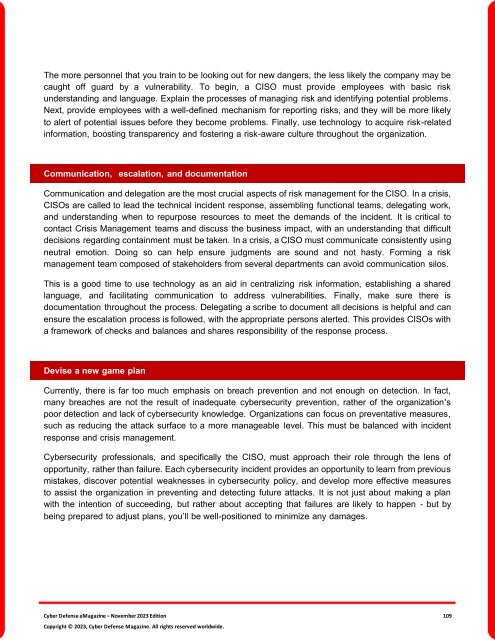The Cyber Defense eMagazine November Edition for 2023
Cyber Defense eMagazine November Edition for 2023 #CDM #CYBERDEFENSEMAG @CyberDefenseMag by @Miliefsky a world-renowned cyber security expert and the Publisher of Cyber Defense Magazine as part of the Cyber Defense Media Group as well as Yan Ross, Editor-in-Chief and many more writers, partners and supporters who make this an awesome publication! 196 page November Edition fully packed with some of our best content. Thank you all and to our readers! OSINT ROCKS! #CDM #CDMG #OSINT #CYBERSECURITY #INFOSEC #BEST #PRACTICES #TIPS #TECHNIQUES
Cyber Defense eMagazine November Edition for 2023 #CDM #CYBERDEFENSEMAG @CyberDefenseMag by @Miliefsky a world-renowned cyber security expert and the Publisher of Cyber Defense Magazine as part of the Cyber Defense Media Group as well as Yan Ross, Editor-in-Chief and many more writers, partners and supporters who make this an awesome publication! 196 page November Edition fully packed with some of our best content. Thank you all and to our readers! OSINT ROCKS! #CDM #CDMG #OSINT #CYBERSECURITY #INFOSEC #BEST #PRACTICES #TIPS #TECHNIQUES
Create successful ePaper yourself
Turn your PDF publications into a flip-book with our unique Google optimized e-Paper software.
<strong>The</strong> more personnel that you train to be looking out <strong>for</strong> new dangers, the less likely the company may be<br />
caught off guard by a vulnerability. To begin, a CISO must provide employees with basic risk<br />
understanding and language. Explain the processes of managing risk and identifying potential problems.<br />
Next, provide employees with a well-defined mechanism <strong>for</strong> reporting risks, and they will be more likely<br />
to alert of potential issues be<strong>for</strong>e they become problems. Finally, use technology to acquire risk-related<br />
in<strong>for</strong>mation, boosting transparency and fostering a risk-aware culture throughout the organization.<br />
Communication, escalation, and documentation<br />
Communication and delegation are the most crucial aspects of risk management <strong>for</strong> the CISO. In a crisis,<br />
CISOs are called to lead the technical incident response, assembling functional teams, delegating work,<br />
and understanding when to repurpose resources to meet the demands of the incident. It is critical to<br />
contact Crisis Management teams and discuss the business impact, with an understanding that difficult<br />
decisions regarding containment must be taken. In a crisis, a CISO must communicate consistently using<br />
neutral emotion. Doing so can help ensure judgments are sound and not hasty. Forming a risk<br />
management team composed of stakeholders from several departments can avoid communication silos.<br />
This is a good time to use technology as an aid in centralizing risk in<strong>for</strong>mation, establishing a shared<br />
language, and facilitating communication to address vulnerabilities. Finally, make sure there is<br />
documentation throughout the process. Delegating a scribe to document all decisions is helpful and can<br />
ensure the escalation process is followed, with the appropriate persons alerted. This provides CISOs with<br />
a framework of checks and balances and shares responsibility of the response process.<br />
Devise a new game plan<br />
Currently, there is far too much emphasis on breach prevention and not enough on detection. In fact,<br />
many breaches are not the result of inadequate cybersecurity prevention, rather of the organization's<br />
poor detection and lack of cybersecurity knowledge. Organizations can focus on preventative measures,<br />
such as reducing the attack surface to a more manageable level. This must be balanced with incident<br />
response and crisis management.<br />
<strong>Cyber</strong>security professionals, and specifically the CISO, must approach their role through the lens of<br />
opportunity, rather than failure. Each cybersecurity incident provides an opportunity to learn from previous<br />
mistakes, discover potential weaknesses in cybersecurity policy, and develop more effective measures<br />
to assist the organization in preventing and detecting future attacks. It is not just about making a plan<br />
with the intention of succeeding, but rather about accepting that failures are likely to happen - but by<br />
being prepared to adjust plans, you’ll be well-positioned to minimize any damages.<br />
<strong>Cyber</strong> <strong>Defense</strong> <strong>eMagazine</strong> – <strong>November</strong> <strong>2023</strong> <strong>Edition</strong> 109<br />
Copyright © <strong>2023</strong>, <strong>Cyber</strong> <strong>Defense</strong> Magazine. All rights reserved worldwide.

















